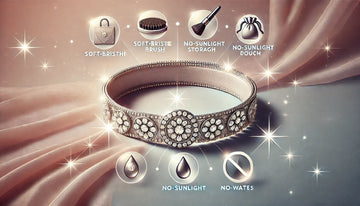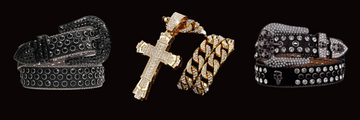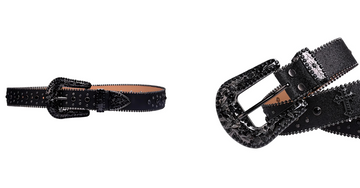Protecting Your Rhinestone Belt from Wear and Tear
Rhinestone belts are a dazzling addition to any outfit, instantly elevating your look with a touch of glamour. However, to keep them looking flawless, proper care and maintenance are essential. This guide covers the best cleaning methods, storage tips, and protective measures to help preserve your belt’s brilliance and longevity.
Understanding the Vulnerabilities of Rhinestone Belts
Fragility of Rhinestones
Rhinestones, typically crafted from glass, crystal, or acrylic, are delicate by nature. Without proper care, they can easily become scratched, chipped, or lose their shine over time.
Leather and Fabric Durability
Most rhinestone belts feature a leather or fabric base, which can be prone to wear and tear. Over time, these materials may crack, stretch, or fade, especially with frequent use.
Environmental Factors
Exposure to moisture, heat, or direct sunlight can accelerate the deterioration of both the rhinestones and the belt’s base. This can result in fading, warping, or weakening of the materials, reducing the belt’s longevity.
Cleaning Your Rhinestone Belt
Gentle Dusting
Use a soft, lint-free cloth or a makeup brush to gently dust rhinestones and remove surface dirt without scratching them.
Spot Cleaning
For stubborn spots, dampen a microfiber cloth with water and mild soap. Lightly dab the affected area, avoiding excessive moisture to prevent damage to the leather or fabric.
Avoid Harsh Chemicals
Never use abrasive cleaners, alcohol, or ammonia-based products, as they can corrode rhinestones and weaken the adhesive that holds them in place.
Proper Storage Techniques
Use a Belt Organizer
Hang your belt on a padded hanger or roll it loosely and store it in a designated belt organizer to prevent creases or deformation.
Protect from Sunlight
Store your belt in a cool, dry place away from direct sunlight, which can fade the colors and weaken the materials over time.
Keep It Separate
Avoid storing your rhinestone belt with sharp objects or heavy accessories that might scratch or crush the rhinestones.
Preventing Damage During Wear
Avoid Excessive Tension
When fastening your belt, ensure it isn’t pulled too tight, as this can strain the leather or fabric and loosen the rhinestones.
Watch Out for Snags
Be cautious when wearing your belt with delicate fabrics like silk or lace, as the rhinestones or settings may catch and cause damage.
Limit Exposure to Elements
Avoid wearing your rhinestone belt in rainy or humid conditions to protect it from moisture damage.
Regular Maintenance Tips
Inspect for Loose Stones
Periodically check for loose rhinestones or weakened settings and secure them with a strong, clear adhesive designed for jewelry repair.
Polish the Buckle
If your belt features a metal buckle, use a jewelry polishing cloth to keep it shiny and rust-free.
Condition the Leather
Apply a leather conditioner occasionally to prevent cracking and maintain the suppleness of the belt material.
When to Seek Professional Help
Professional Cleaning
For heavily soiled belts or stubborn stains, consult a professional cleaner who specializes in leather and delicate accessories.
Repairs
If rhinestones are missing or the leather is severely damaged, seek professional repair services to restore your belt to its original glory.
Conclusion
Protecting your rhinestone belt from wear and tear requires consistent care and mindful handling. By following these cleaning, storage, and maintenance tips, you can ensure that your belt remains a sparkling and stylish addition to your wardrobe for years to come.
Looking for high-quality rhinestone belts or replacements? Visit The Rhinestone Belts for a stunning selection of Western-inspired rhinestone belts that combine style and durability.
FAQs
1. Can I wash my rhinestone belt in water?
No, it’s best to avoid submerging your belt in water. Use spot-cleaning methods with minimal moisture instead.
2. How do I fix a loose rhinestone?
Secure loose rhinestones with a clear jewelry adhesive designed for delicate items.
3. Can I use a regular brush to clean my rhinestones?
No, a soft makeup brush or lint-free cloth is recommended to avoid scratching the rhinestones.
4. How often should I clean my rhinestone belt?
Clean your belt whenever it appears dusty or dirty, or before storing it for long periods.
5. Are all rhinestone belts made of leather?
No, some belts use fabric or synthetic materials as their base, but the care principles remain similar.




